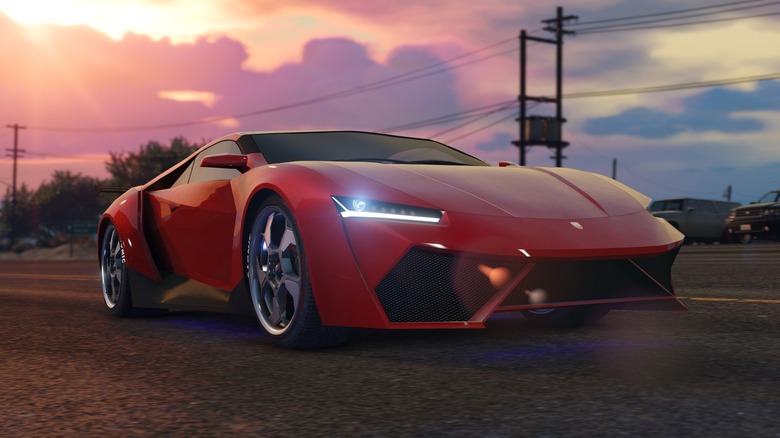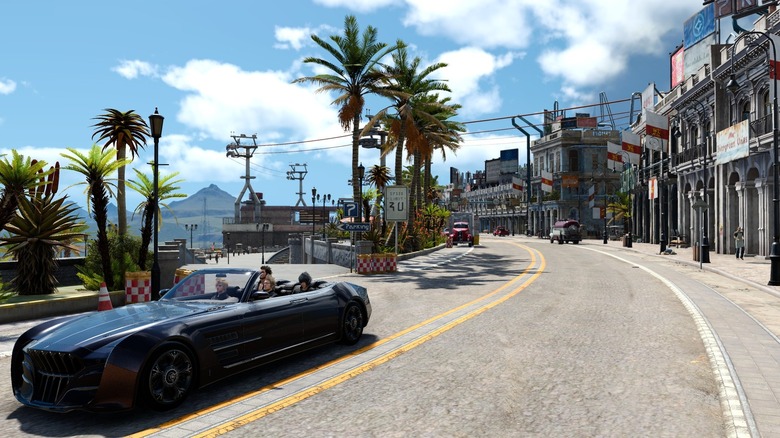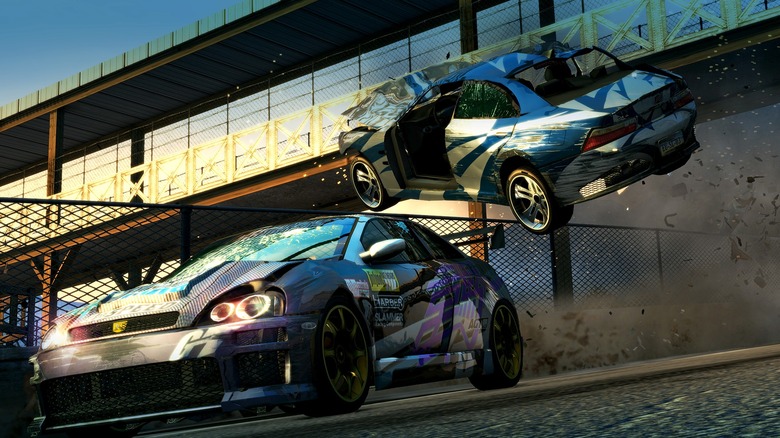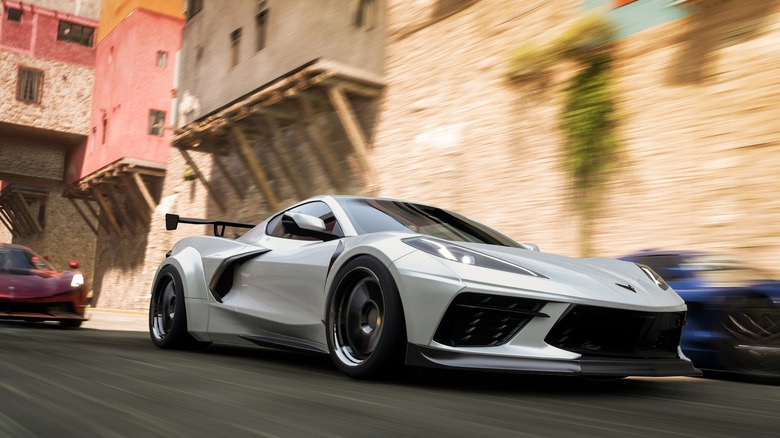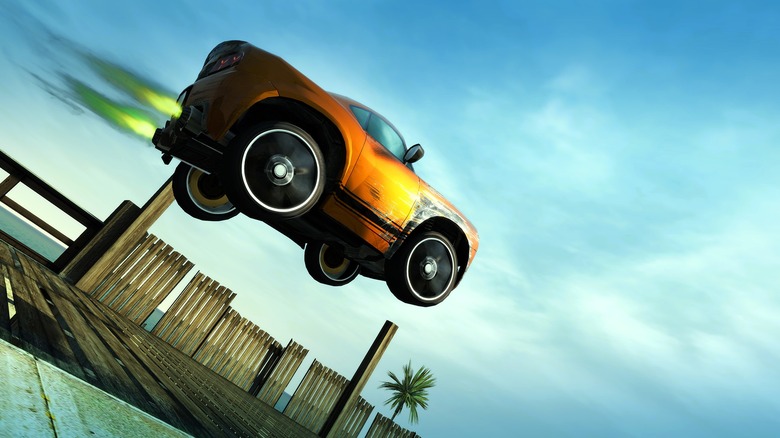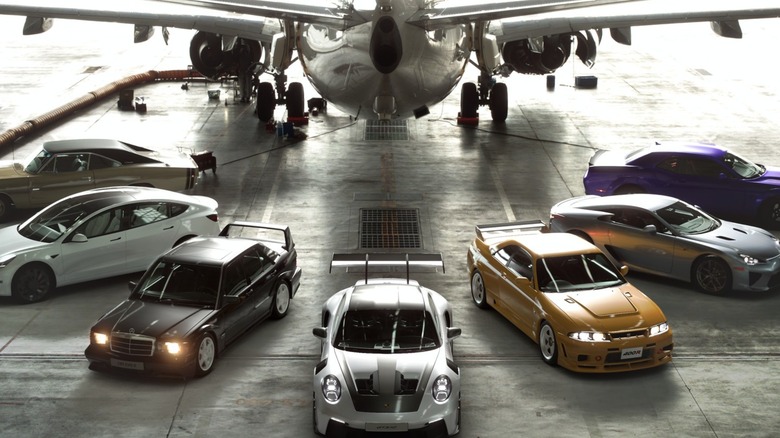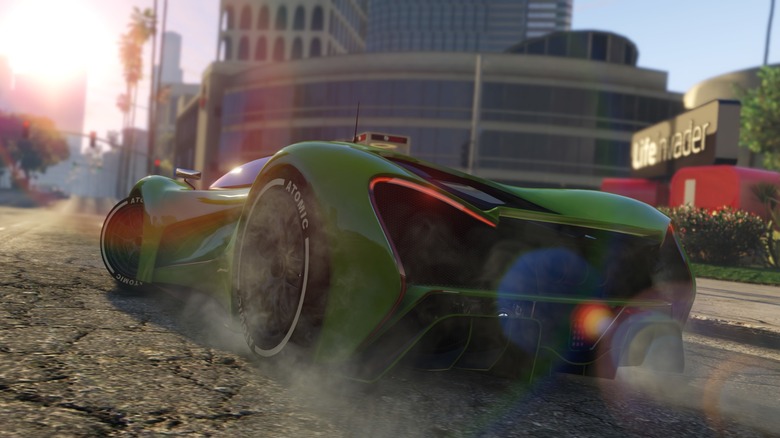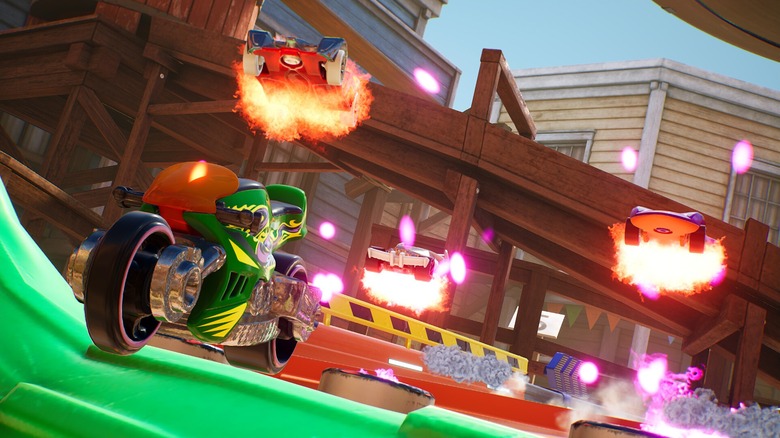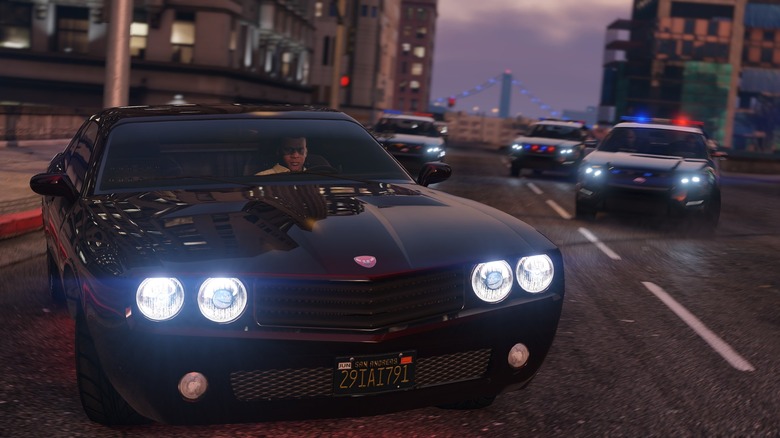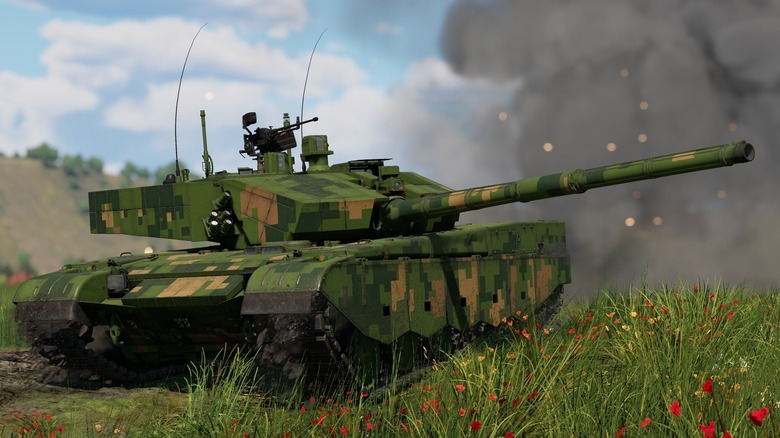10 Things Video Games (Almost) Always Get Wrong About Cars
Video games are, by definition, unrealistic. Characters can jump while in midair for extra height, recover from grievous injuries by eating food, and most unrealistic of all, regularly get a good night's sleep. Granted, no two games share the exact same mechanics, so some might provide better representations of (parts of) reality. However, most video games never seem to get vehicles quite right, especially cars.
Cars are common in video games. The "Grand Theft Auto" series involves a lot of driving and stealing cars — their maps are too big to navigate without one. And of course, racing games like the "Gran Turismo" and "Mario Kart" franchises are all about driving sports vehicles around racing tracks. However, even when most of a game's focus is spent on cars, the final product has trouble nailing the feel of driving a car. Sometimes these shortcomings are caused by limitations in the game engine or game development process, other times they're simple gamifications meant to streamline the experience and cut down on busy work. Regardless of the reason, you should never assume you know how to drive a car in real life just because you drove one in a video game, no matter how many videos you see of kids claiming they saved their grandmother thanks to "Mario Kart."
Read on to learn just how poorly video games capture the reality of owning and driving vehicles, especially cars.
Gas and maintenance aren't optional
Everything mechanical devices needs energy, including cars. Depending on the engine, a car might require either gasoline or diesel. To drive as far as possible, most vehicles have large tanks — or batteries in the case of electric vehicles — that take a while to fill. Annoying, but part of the price of admission for car owners. In real life, at least.
This is the most obvious thing video games get wrong about cars: You almost never have to maintain them. Gasoline is used to blow up enemies more than it is to fuel cars. However, this depends on the kind of experience developers want to provide. Gas isn't a concern in most games like "Grand Theft Auto," but titles with survival mechanics like "Mad Max" and "Organ Trail" emphasize the necessity of gas since a fully functioning car is critical to survival. "Final Fantasy XV" is an outlier, but many players think the game's gas meter was designed to waste their time.
Most video games also remove the need for general car maintenance. No oil changes, tire rotations, or timing belt replacements. Well, mostly. Again, survival titles that feature cars include some vehicle upkeep since maintenance is the name of the game. However, the system is often stripped down and simplified to only include more generic and vague issues. "Car Mechanic Simulator 2021" provides the most accurate car maintenance experience so far, but you can't drive the cars you work on in that game.
You can't brush off a crash
Video games never portray damage accurately. Characters can shrug off gunshot wounds and even cure deadly poisons with a little bit of shut-eye, and cars often get similar treatment.
The damage you can inflict on cars in video games is determined by the intended experience and the game engine. Older titles, especially more arcade-y ones trade realism for pure adrenaline and speed, usually rendering cars completely invincible. At most, cars often bounce off obstacles and resume racing as normal, or blow up at the slightest touch for the sake of spectacle. Even when games let you completely wreck your car, they often limit environmental damage to the bare minimum. You can demolish trees, streetlights, and fences, but buildings are generally off limits.
Predictably, since video games don't do much in regards to surface damage, they often ignore less superficial mechanical injuries. The most obvious example comes from jumps. In video games, jumping off ramps can net players points and achievements, yet if you tried these kinds of stunts in real life, you would snap your car's suspension in two. Another common driving technique in video games is redlining — pushing an engine so hard that the RPM maxes out and hits the red line on the tachometer. This tactic helps you win races in video games, but in the real world constant redlining is bad for your engine. Unless you're trying to speed-run an engine replacement, that is.
Performance isn't all or nothing
One of the most important components in any car is its gears. These transmit power from the engine to the wheels, and changing gears alters how fast it can go and in what direction. Automatic transmission streamlines the process, but you still have to use it to properly drive a car — in the real world, at least.
With most games, especially those with vehicles that have manual transmissions, cars don't really have any gears. You just hold down the acceleration button, keep going in a straight line, and the car will reach max speed. It's simple, but unrealistic. In reality, you have to keep an eye on your speed and shift up and down accordingly. If you want a mostly accurate approximation of this process, try racing simulators like "Gran Turismo" and "Forza," as their controls include buttons for shifting gears. You can still let the game change gears automatically, but you won't find your name on any leaderboards.
Wheels aren't treated much better, either. Experienced drivers know that front-wheel drive, rear-wheel drive, four-wheel drive, and all-wheel drive provide vastly different experiences. However, these nuances are absent in most games. "Grand Theft Auto 5" and racing simulators provide more realistic approximations, but even they are restricted by their game engine. Rounding a corner at top speed in "GTA" is not only possible but encouraged, while performing the same trick in the real world and games like "Forza" will make your car flip out.
Cars always obey the laws of physics
Video games are fictional worlds, and they often have a tenuous grasp of real-world physics. Characters can effortlessly swing swords bigger than they are and survive falls off skyscrapers. And cars in video games are even more outrageous.
Let's start with the most obvious: If a racing game is arcade-y, it forgoes realism for fun. In "Cruis'n Blast," you can bank left and right to change lanes, pull a side wheelie, and even spin out without losing speed. Many other racing titles let you speed up by drifting, which is in flagrant violation of the conservation of momentum. However, that is all part of the fun. Developers include these features in games to provide pulse-pounding races, realism be darned. While studios that create more simulated experiences avoid most crimes against physics, they often still unintentionally break the laws of gravity, too.
No matter the game genre or engine, developers can't seem to figure out just how gravity affects cars. In the real world, even the most insane stunt jumps only last a few seconds, but video games stretch these out significantly. The worst offenders are, ironically, racing simulators like "Forza." For all the realism their game engines provide, they have trouble nailing jumps, and under the right conditions, the engine completely breaks and gives a car so much hang time that the game can't render the world properly.
Modifications should be potentially infinite
For some car owners, half the fun lies in transforming their vehicle. Unfortunately, video games don't offer as many customization options as real life.
In the real world, car (and other vehicle) modifications are only limited by your budget, expertise, and imagination. You can, say, add some mods that make trucks more suited to the off-road, but if you want to see just how far modifications can take a car, look no further than George Barris. The man made a career out of customizing cars for movies and TV shows; his most iconic creations included the "Jurassic Park" tour vehicle and the 1966 Batmobile, which were built out of a 1992 Ford Explorer and a 1955 Ford Lincoln Futura, respectively. His modifications even let people drive the tour vehicles from the trunk, thus completing the movie magic illusion that the cars were fully autonomous.
Car modifications in video games are comparatively far more limited. Usually, you can only tweak parts to add more horsepower or decrease weight. If the game has vehicular combat, modifications can get a little more creative, but they often boil down to adding extra armor or increasing ramming speed damage. We can probably chalk up these limitations to game engine, budget, and development time restrictions, but what about when a game mislabels a modification? Many games claim rear car spoilers are purely aesthetic, but they actually make a difference in downforce, when installed correctly, at least. "Grand Theft Auto V" gets this right, but it's in the minority.
Turbo isn't a speed boost button
People love going fast almost as much as we love seeing immediate results, and that's developed into a downright obsession with surpassing a vehicle's limits by boosting its speed. This technology kind of exists in real life, but depictions of it have been warped by fantasy.
If a video game, movie, or TV show revolves around or devotes a significant amount of time to car racing, odds are it includes a "turbo boost" that rockets the car forward in an instant. This feature can be activated with the push of a button, and using it at the right moment can mean the difference between first and last place. Games such as "Super Mario Kart," "Burnout Paradise," and "Hot Wheels Unleashed" are good examples of turbo systems in video games, just not good examples of turbo systems in real life.
In the real world, cars can be modified with something known as a turbocharger, which increases the amount of power an engine can provide, thus improving top speeds. However, despite what the entertainment industry would make you believe, turbochargers don't shoot your car forward like a rocket with the touch of a button. Instead, these systems "spool up" after the engine reaches a specific RPM (which differs from engine to engine), providing more horsepower up to a certain amount, which itself is determined by the turbocharger. If someone is driving a car and is far behind the other racers, a turbocharger won't significantly increase their speed until after they've already lost.
Nitrous doesn't turn your exhaust into a flamethrower
Following on from the previous entry, giving cars a sudden burst of speed isn't enough for some audiences. It's not true acceleration unless part of the car transforms or expels something that exudes power. At least, that is what we've been led to believe.
When a car uses a turbo boost in a video game (or movie or TV show), flames often shoot out of the exhaust. Not only does this look cool, but it also helps audiences associate gouts of flame with speed. Whenever a work of fiction tries to defend this depiction, nitrous oxide (NOS) is the go-to explanation. This depiction is rooted in truth but largely fictional.
NOS systems can temporarily provide more power for a car's engine, not unlike a video game power-up. However, NOS doesn't make cars spit flames out the exhaust — at most, it produces a jet of clouds when purged from the system. The idea of flames jetting out of pipes most likely comes from the very real event known as backfire. Backfiring occurs when fuel combusts outside of the fuel cylinder — often a result of dumping too much fuel into the engine — causing fire to travel up and out through the exhaust.
This is actually how turbocharger anti-lag systems (ALS) work. They significantly reduce the time a turbocharger takes to spool up, but do so by combusting fuel in areas that aren't designed for it.
Road conditions are never constant
Cars, and by extension other vehicles, make up most of the driving experience, but not all of it — roads take up the rest. Wherever you're going, you need roads. However, in real life roads and driving conditions are never consistent. In video games, road conditions are impossibly stable.
Paved roads in cities have an ideal level of smoothness; bumps, potholes, and other products of general wear and tear don't exist. Plenty of games have bumpy roads, but these are often in more intentionally rural and mountainous regions. And again, every individual bump remains constant from start to finish.
Roads in video games are also characterized by the static nature of driving conditions. Many games, especially open world titles, can have weather, but inclement weather doesn't often exist in video games. Rain, for example, at most only slightly affects visibility and makes roads a bit slipperier — there's no danger of hydroplaning like in the real world. The same applies to snow, freezing rain, and other extreme weather conditions. And these aren't the only detrimental driving conditions video games can't simulate.
Traffic is another example, especially in games like "Grand Theft Auto." Either due to rendering limitations or intentional design, you typically only see a few cars temporarily stopped in any given location; realistic bumper-to-bumper scenarios that go on for hours are never replicated. Then again, being stalled in one location would detract from the fun, so maybe that's one accurate simulation we could do without.
You can't run from the law
In video games, you often find yourself on the wrong side of the law. When this happens, you understandably have to escape cops, typically in ways that scream "Don't try this at home, kids!"
If you have played games like "Grand Theft Auto," you know that the cops in those titles are as aggressive as they are braindead. They will pull their guns on you if you so much as walk in front of their car, but if you do something actually illegal, you can easily escape them a multitude of ways, all of which revolve around them losing sight of you. The most obvious (but not necessarily easiest) way is to outrun them in your car.
Given how vehicles are coded in video games, many virtual cars can outpace cop cruisers. In real life, this is next to impossible for anything short of a Ferrari. And even if you get out of sight, police have tons of tricks to keep an eye out for perpetrators and slow them down, including road spikes and helicopters. They also don't stop looking when a perp loses them. Meanwhile, in "Grand Theft Auto," cops only call in the big guns when you cause a lot of damage, and by big guns, I mean the army. Once the heat dies down, they forget you committed a crime and treat you like any other citizen. Is it any wonder why crime is a problem in "GTA"?
Tanks are not overpowered
When a story features the army, developers seem almost obliged to include tanks. These armor-clad vehicles are often portrayed as slow, lumbering titans of firepower. While some admittedly live up to this legend, most works of fiction spread a lot misconceptions about tanks, video games included.
Many video games (and movies and TV shows) lean into the feeling that tanks are unstoppable. When you pilot them, it's meant to feel like a "power fantasy" mode, encouraging you to cause as much destruction as possible. However, while real tanks have heavy armor that can withstand infantry firearms, plenty of weapons can rip right through them. To its credit, the game "War Thunder" goes one step further by simulating what is underneath the armor. Instead of giving vehicles traditional video game health bars, the right hit to the wrong spot, such as an ammunition magazine, can instantly put you out of commission.
One of the most egregious facts about tanks that video games constantly get wrong is how to control them. Or to be more specific, how many people you need to control them. If a game lets you hijack a tank, they often show the protagonist piloting it on their own. In reality, almost every tank requires a crew of soldiers, all with different jobs ranging from scoping out targets to reloading the main cannon. The only tanks small enough to be manned by one person were prototypes that never made it to the battlefield.
